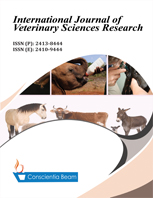Occurrence and Anti-Fungal Sensitivity Testing of Candida Species Isolated from Canine Conjunctivitis
DOI:
https://doi.org/10.18488/journal.110/2016.2.2/110.2.8.14Abstract
Fungal infection in dogs and other domestic pets caused by Candida species have been previously reported. Several available antifungal drugs for treatment of yeast associated infections have been used with diverse effects. This study establishes antifungal susceptibility profile on identified Candida species isolates associated with canine conjunctivitis using disks diffusion method as described by NCCLS (M44-A). The antifungal disks used include Amphotericin-B (20mcg), Nystatin (100units), Itraconazole (10mcg), Ketaconazole (10mcg), Fluconazole (25mcg). The identified Candida species were C. albicans, C. krusei, C. tropicalis and C. parapsilosis. Percentage susceptibility was high in both Amphotericin B (77.27%) and Nystatin (58.18%), while Itraconazole showed (54.54%), Ketoconazole (55.45%) and Fluconazole was least (11.82%). The sensitivity ranking showed Amphothericin B > Nystatin > Itraconazole > Ketoconazole > Fluconazole and increased resistance amongst the Azoles especially Fluconazole (70.90%) in comparison with Polyenes. C. albicans showed the highest resistance (84.51%) to both Fluconazole and ketoconazole (67.61%). C. parapsilosis showed 63.64% and 61.54% percentage resistance to Nystatin and Itraconazole respectively. In conclusion, this finding showed that Amphotericin B and Nystatin were most effective against isolated Candida species. Proper diagnosis of the underlying ailment is necessary in conjunction with routine anti-fungal susceptibility testing to avoid drug abuse and resistance.

